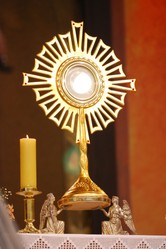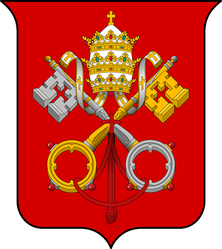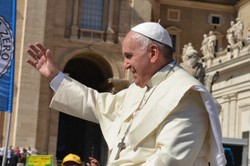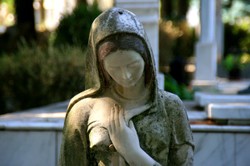Some years ago, the late Reverend Ian Paisley, the staunchly anti-Catholic head of the Free Presbyterian Church of Ulster, was debating his position at the Oxford Union, a renowned debating society, when he pulled out a piece of communion bread and declared that Catholics believe that this is Christ. Well, I hope that he had not got his hands on a consecrated host, but in any case,like all propagandists he was thinking in caricatures. While the church has an explanation of the real presence of Christ in the Eucharist, it acknowledges that the Eucharist is a profound mystery, the full understanding of which is beyond human comprehension. So yes,it is the body of Christ, but in a mysterious way far beyond the simplistic posturings of the likes of Dr Paisley.
We adhere to this doctrine because we get it from Jesus.The gospels tell how at the Last Supper Jesus took the bread and wine and declared that they were his body and blood.In other words they were to be his physical manifestation when he had gone from sight.The breaking of bread and the Lord's Supper are mentioned in the Acts of the Apostles and the Pauline letters, so this shows that the Eucharist was central to the life of the church,which regarded it as the visible manifestation of Christ to his people.
However, one thing must be emphasised. It is not the body of Christ as he was when he walked in Israel, that is believed to be present, but the risen Christ who at the resurrection acquired a glorified body that transcended earthly limitations that is present. We note from the resurrection stories in the gospels that after the resurrection Jesus seems to have been free of physical constraints and at time was not recognisable even by his close companions, and in the light of this liberation it becomes less surprising that the church accepts that Jesus becomes manifest as the Eucharistic elements of bread and wine.
Some find it incredible that Catholics can seemingly fly in the face of commonsense,for surely bread cannot be a body, and they see the Eucharist as merely a memorial. But common sense is not a good guide to reality,for the world revealed by physics is far from commonsensical, and reality can be very strange to us. Can it be so surprising that God is even stranger than the created universe is? Furthermore, when at the Last Supper Jesus said "Do this in memorial of me he used the word anamnesis, which means more than simple remembering, but reliving,making present again, so Jesus was implying that he would continue to be among his disciples through the Eucharistic elements of bread and wine after his departure.
The Christian church has tried to find a philosophical formulation for the real presence of Christ in the Eucharist. Roman Catholicism uses the term transubtantiation, which mean that the substance of bread and wine are changed but their appearances have not. Some other churches use consubstantiation,meaning that the elements remain bread and wine, but become linked to the risen Christ. It is possible to argue for hours about this issue, but what matters is the real presence of Christ among his people.










 Pilgrimage. A review20 days ago
Pilgrimage. A review20 days ago
 Leo the Fourteenthon 05/09/2025
Leo the Fourteenthon 05/09/2025
 The Melsonby Hoardon 03/25/2025
The Melsonby Hoardon 03/25/2025




Comments
Jesus did not say how many,there was no rule. I presume that as people eat one main meal a day, daily Eucharist would be reasonable, but it is not compulsory
The second paragraph to the first subheading, Beliefs and caricatures, defers to the Last Supper.
How many times per day or per week might His disciples have understood Jesus Christ as wishing their togetherness over bread and wine?
We must remember that the creed speaks in human language about reality that transcends language.
Right. I just noticed that in The Creed, for instance, they are separated somewhat.
An important Christian teaching is that you do not deal with a member of the Trinity in isolation from the others. So the Spirit is the Spirit of Christ which he received from the Father.
I like your comments that "the Eucharist [mass,Lord's Supper] is the visible expression of the bond that church members share with each other. To participate in Eucharist is to take part in the life of the church." I also like the Orthodox view that it's the Holy Spirit flowing through the bread and wine, but why do they say Holy Spirit and not Christ?
Derdriu, communion on Sundays is in both kinds. On weekday masses it depends on the priest's decision. If you want a sequel to my article there will be a sequel, but I will need to think about it, and I have to say that I have a book review planned, but that will take some time.
The Old Catholics,who separated from Roman Catholicism after 1870, acquired their ordination from the bishop of Utrecht, who was in valid apostolic succession. So they are validly ordained.
Later on some Anglo-Catholics, from the Church of England/Episcopalian church, had doubts about their ordination, as it derived from bishops not ordained as sacrificing priests, for they rejected the idea of the mass as a sacrifice. These worried Anglicans sought ordination from the validly ordained Old Catholic bishops, and hence any of them or their successors are validly ordained.
Certain schismatic bishops are validly ordained for the same reason, for there was one schismatic bishop in the nineteenth century who dispensed ordination willy nilly!
Yes BSG, I fully agree. But I see the entire redemptive act as being mediated through the living Christ who was crucified and rose again.
frankbeswick, Thank you for the back- and front-stories and the product lines. Is there a tendency toward Holy Communion of one or both kinds on your side of the pond?
Is there going to be a sequel in the form of Eucharistic sacrifice and Eucharistic devotions?